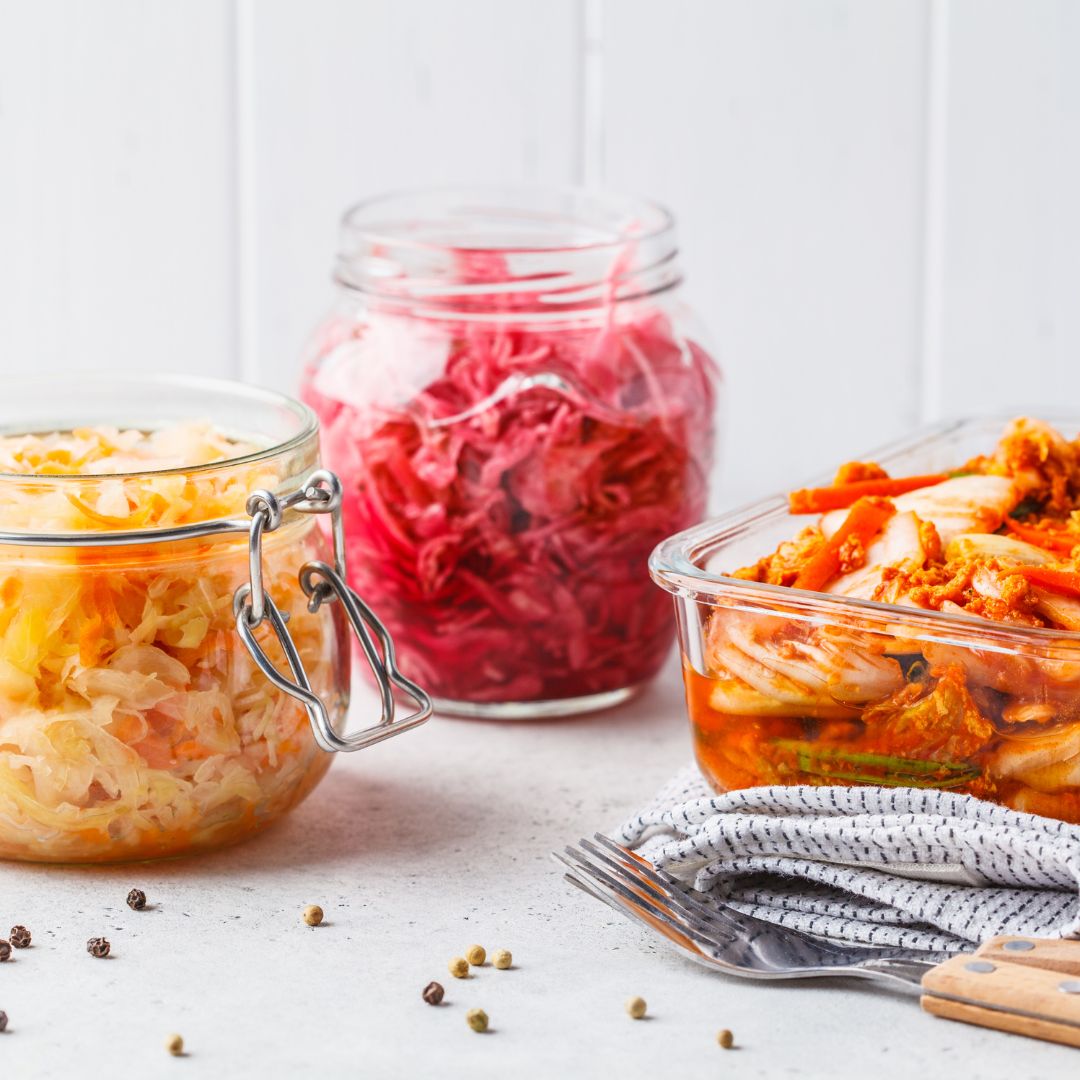
Warming Turmeric and Ginger Winter Tea
Turmeric and ginger have a long history of use in traditional cooking and herbal practices, but they also have a growing body of research supporting their role in inflammation, immunity and metabolic health.
Turmeric contains curcumin, a natural compound studied for its anti-inflammatory and antioxidant effects. Ginger contains gingerols and shogaols, which support digestion, circulation and immune balance.
For women with PCOS this combination can be particularly supportive. Chronic low-grade inflammation is a common feature of PCOS, and warming ingredients like turmeric and ginger may help calm inflammatory pathways while supporting winter immunity. Their gentle effects on digestion can also be helpful during colder months when heavier meals are more common.
This simple winter tea is an easy way to enjoy these benefits in a soothing, daily ritual.
Key ingredients for PCOS health
This recipe uses everyday ingredients that offer natural support for inflammation, hormone balance and immunity.
Fresh ginger
Supports digestion and may help regulate inflammation. It also adds gentle heat that feels comforting on winter days.
Ground or fresh turmeric
Provides curcumin, known for its antioxidant and anti-inflammatory effects. When combined with black pepper, absorption improves.
Lemon
Adds vitamin C and a fresh flavour. Vitamin C contributes to normal immune function.
Honey (optional)
Offers natural sweetness and antioxidants. A very small amount can make the tea more comforting without overwhelming blood sugar.
Black pepper
Enhances the absorption of curcumin and brings warmth to the drink.
These ingredients can be adjusted based on your taste and tolerance.
Ingredients:
Serves: 2
Method:
The result is a soothing golden tea that feels grounding, warming and supportive during the colder months.
Tips for making ahead and freezing
This recipe is easy to make in larger batches and store for later use.
This tea makes a nourishing addition to winter self-care and can complement your wider anti-inflammatory and PCOS-supportive habits.

Top Tips to Support PCOS this Winter
Why winter can trigger inflammation and flare-ups
Winter often brings a noticeable shift in energy, cravings and symptoms. Darker days, colder weather and changes in routine all influence how the body regulates inflammation. People commonly experience more colds, more fatigue and more reliance on comfort foods during this time, which can place additional pressure on metabolic health.
For those with PCOS, these changes can feel particularly challenging. PCOS is closely linked with chronic low-grade inflammation. Winter may amplify this due to lower vitamin D, disrupted sleep, reduced movement and a tendency toward richer foods. This can lead to more fatigue, skin flare-ups, cravings, mood changes and slower recovery from illness.
The positive news is that simple, sustainable habits can make a meaningful difference to how your body handles winter.
Tip 1: Focus on anti-inflammatory foods
Nutrition is one of the most effective ways to support inflammation. Many whole foods contain natural compounds that help regulate immune responses, stabilise blood sugar and support hormone balance.
Here are some foods with well-researched anti-inflammatory properties:
Turmeric: Contains curcumin, shown to support inflammatory regulation. Add it to soups, stews, curries or warm drinks. Black pepper enhances absorption.
Ginger: Supports digestion and may help manage inflammation. Fresh ginger works well in teas, stir-fries, porridge and broths.
Berries: Rich in polyphenols that help moderate inflammation. Frozen berries are ideal for winter and easy to add to porridge or yoghurt.
Leafy green vegetables: Kale, spinach, cabbage and cavolo nero provide antioxidants, magnesium and fibre which all support immune and metabolic health.
Extra virgin olive oil: A key feature of traditional Mediterranean diets, associated with lower inflammatory markers. Drizzle on salads, vegetables or soups.
Garlic and onions: Contain prebiotic fibres and sulphur compounds that support a balanced gut microbiome, which influences inflammation.
Oily fish: Salmon, sardines, mackerel and herring provide omega 3 fatty acids that support inflammatory balance and cardiovascular health.
Herbs and spices: Cinnamon, rosemary, thyme and oregano offer antioxidant support and add flavour to winter meals.
Warming soups, stews, tray bakes and slow-cooked dishes make it easy to include these ingredients regularly.
Tip 2: Balance blood sugar with warming meals
Large spikes in blood sugar can increase inflammation and lead to energy crashes, cravings and hormonal fluctuations. Winter comfort eating often involves sugary snacks and refined carbohydrates that contribute to these patterns.
Balancing meals helps create steady energy. A useful approach is to include:
Meals such as lentil soup, roasted vegetables with salmon, turkey chilli, or quinoa tofu bowls with winter greens can provide warmth and stability throughout the day.
Tip 3: Prioritise rest and sleep
Sleep has a powerful influence on inflammation. Winter often disrupts sleep patterns due to darker mornings, reduced daylight exposure and seasonal stress.
Low-quality sleep can affect blood sugar control, hunger hormones and mood, all of which are closely connected to PCOS.
Helpful habits include a consistent sleep and wake routine, reduced screen use in the evening and getting outside for daylight exposure when possible. Many people find that improving sleep quality significantly boosts their winter wellbeing.
Tip 4: Gentle movement over pushing too hard
Movement helps regulate inflammation, supports insulin sensitivity and improves mood. During winter it can be tempting to skip exercise or, at the other extreme, push harder to counterbalance food choices.
Gentle, consistent movement is often more supportive. Activities such as walking, yoga, pilates, swimming or light strength training can be enough to improve metabolic health without overwhelming the body. Regular movement also supports immune resilience and emotional wellbeing.
Tip 5: Gut health support in winter
Gut health plays a key role in inflammation, immunity and hormone regulation. Winter routines can affect digestion, microbiome diversity and bowel habits. Supporting your gut can therefore improve resilience during colder months.
Aim to include fibre rich vegetables, fermented foods such as kefir, sauerkraut or live yoghurt, and prebiotic foods like oats, garlic, onions and flaxseed. These support beneficial gut bacteria and help maintain a healthy gut barrier.
If digestive symptoms such as bloating, irregular stools or reflux are frequent, it may indicate underlying imbalances such as dysbiosis or SIBO. Supporting the gut often improves inflammation, energy and hormonal symptoms. Check my gut health blog here.
Bringing it all together
Winter can be a challenging season for many of us managing PCOS. The combination of reduced daylight, colder weather, disrupted routines and dietary changes places extra strain on the body. Small, consistent habits can make a noticeable difference to inflammation, mood and metabolic balance.
Including nutrient dense foods, balancing blood sugar, improving sleep, staying gently active and supporting gut health all help your body feel more resilient in winter. These changes do not need to be complicated or restrictive. Even a few simple adjustments can help reduce flare-ups, stabilise energy and support your overall wellbeing.
If you notice that winter always leaves you feeling more tired, inflamed or out of balance, now is the ideal moment to take supportive action.
If you feel ready to support your hormones, inflammation and winter wellbeing more deeply, help is available. Why not get in touch?

The Gut–Immune Connection: Why Your Microbiome Matters More in Winter
Winter often brings a rise in colds, flu, a touch of COVID, but overall slower recovery and lower energy. While many people blame the weather alone, the gut actually plays a major role in how well the immune system responds at this time of year. The gut and immune system are closely linked, and the bugs living in your gut help shape how your body reacts to viruses, inflammation and stress.
For women living with PCOS, this connection is especially important. Gut health influences inflammation, metabolic balance, cravings, hormone regulation and resilience, all of which can feel more sensitive during winter.
How Gut Health Shapes Immunity
Around seventy per cent of the immune system sits in and around the gut. The gut lining acts as a physical barrier, while immune cells monitor what enters the body. A healthy microbiome helps regulate inflammation, supports nutrient production, and contributes to a calm, balanced immune response.
When the microbiome becomes disrupted, the immune system may overreact or become less efficient. This can mean slower recovery from viruses, greater sensitivity to seasonal changes and more fatigue.
Winter brings natural shifts that can challenge the gut. Less sunlight (so less vitamin D0, dietary changes, comfort eating, reduced movement, and increased stress all influence the gut microbial environment and may alter immune resilience.
Microbiome Diversity and Immune Defence
A diverse microbiome is linked with stronger immune defence, better metabolic balance, reduced inflammation and improved digestion. Lower diversity is associated with greater susceptibility to infections and inflammatory conditions.
Some beneficial bacteria can work to strengthen the gut barrier. When the barrier is strong, the immune system remains calm and balanced. When it becomes compromised, the immune system becomes more alert and inflammation can rise.
Women with PCOS often show lower microbial diversity and higher inflammation. This can contribute to fatigue, cravings, hormonal symptoms and reduced winter resilience.
Prebiotics and Probiotics Explained
Prebiotics are fibres that feed beneficial gut bacteria. They help increase diversity and support the production of short chain fatty acids that regulate inflammation. Examples include garlic, leeks, onions, asparagus, oats, flaxseed and green bananas.
Probiotics are live microorganisms found in fermented foods. They help introduce and maintain beneficial species. Examples include kefir, sauerkraut, kimchi, miso and live yoghurt.
Including even one or two sources of these foods daily can support a healthier microbiome.
Digestive Issues That Affect Immunity: Dysbiosis, SIBO and Reflux
Gut health is not simpply about what you eat. Digestive symptoms can also influence the immune system, inflammation and overall wellbeing. Winter often brings these issues to the surface because the body is under more seasonal stress.
Dysbiosis
Dysbiosis refers to an imbalance in gut bacteria in our microbiome. This may involve too few beneficial microbes, too many inflammatory species or microbial patterns that contribute to excess gas or digestive discomfort.
Signs can include bloating, irregular bowel movements – diarrhoea and/or constipation, fatigue after meals, sugar cravings and skin flare ups. Dysbiosis is associated with inflammation and can influence insulin sensitivity and hormonal balance.
SIBO (Small Intestinal Bacterial Overgrowth)
SIBO occurs when bacteria that belong in the large intestine migrate into the small intestine. This can interfere with digestion and nutrient absorption.
Common signs include bloating that worsens through the day, abdominal discomfort, diarrhoea or constipation, nausea and persistent food reactions. SIBO is often assessed through a breath test which measures hydrogen or methane gases produced by gut bacteria.
Reflux and Upper Digestive Issues
Reflux, heartburn and upper abdominal discomfort can also affect the gut–immune connection. These symptoms may relate to imbalanced gut bacteria, delayed stomach emptying, stress or certain trigger foods.
Reflux can reduce sleep quality and contribute to inflammation, both of which weaken immune resilience. Supporting digestion through balanced meals, eating slowly and avoiding late eating can help.
When Testing Can Help
Testing is not always required, but it can be helpful for people with ongoing digestive symptoms.
Comprehensive stool tests: These provide information on microbial diversity, beneficial and opportunistic bacteria, digestion and absorption markers, inflammation levels and yeast overgrowth.
Breath tests for SIBO: These measure hydrogen and methane gases produced after a specific carbohydrate substrate is ingested. This helps determine whether bacterial overgrowth may be contributing to symptoms.
These tools help build a clearer picture of what is happening in the gut and can guide more personalised nutrition and lifestyle strategies. If you are interested in any of this testing, please do get in touch.
Best Foods for a Winter Proof Gut
Focusing on gut friendly foods at this time of year supports both digestion and immunity.
These foods help create a microbiome that is more resilient and better equipped to support your immune system through winter.
Bringing It All Together
Your gut plays a central role in how well your immune system copes during winter. A diverse and balanced microbiome supports a calmer immune response, steadier energy, healthier digestion and lower inflammation. Digestive issues such as dysbiosis, reflux or SIBO can place extra strain on the gut–immune axis which is why symptoms often feel more noticeable during colder months.
This connection matters even more for women with PCOS. Gut health influences inflammation, insulin sensitivity and hormone regulation, which means that an imbalanced microbiome can make PCOS symptoms feel stronger. Research shows that women with PCOS are more likely to experience dysbiosis and lower microbial diversity, and this can contribute to cravings, fatigue, irregular cycles and higher inflammatory markers. Supporting the gut is therefore not only helpful for immunity but also for managing the wider metabolic and hormonal picture of PCOS.
By focusing on simple, consistent changes such as increasing fibre, including fermented foods, supporting digestion and reducing ultra processed foods, you can strengthen your microbiome and support both immune and hormonal balance. Many women notice fewer flare ups, more stable energy and improved symptoms when they support their gut in this way.
If you feel run down every winter, struggle with digestion or suspect your microbiome needs more attention, this is an ideal time to start making changes. Or if you’d like to know more, why not get in touch?

Tired, Run-down and Inflamed? Is Inflammation Driving your PCOS?
What is inflammation?
Inflammation is the body’s natural defence mechanism. When you injure yourself or catch an infection, your immune system releases chemical messengers to repair tissue and fight off pathogens. This short-term, or acute inflammation, is essential for healing.
However, when the immune system stays slightly switched on over time, a state of chronic low-grade inflammation develops. It’s subtle, often without clear symptoms, but measurable in the body through elevated inflammatory markers such as C-reactive protein (CRP), interleukin-6 (IL-6), or tumour necrosis factor-alpha (TNF-α).
Unlike acute inflammation, this persistent “background” inflammation can quietly affect many systems, including metabolism, hormones, fertility, gut health, and immune resilience. In other words, even though you may not feel overtly unwell, your body may still be under a gentle but ongoing immune strain.
The link between PCOS and chronic low-grade inflammation
Many studies show that women with Polycystic Ovary Syndrome (PCOS) tend to have higher levels of inflammatory markers compared to women without PCOS. This suggests that inflammation is part of the underlying physiology of the condition rather than just a by-product.
Researchers describe PCOS as a metabolic–endocrine–immune disorder, where factors like insulin resistance, excess androgens, and oxidative stress contribute to immune activation. The picture is complex: insulin resistance can increase inflammation, while inflammation itself can worsen insulin resistance, creating a vicious cycle.
Obesity and central fat accumulation often amplify this process because adipose tissue releases inflammatory cytokines. However, even lean women with PCOS can show signs of immune dysregulation, suggesting that the inflammation is not simply weight-related.
This persistent low-level inflammation may also influence how the ovaries function, affect egg quality, and disrupt normal ovulation. For many clients, this explains why symptoms such as fatigue, sluggish recovery from illness, acne, and irregular cycles tend to flare during times of increased stress or poor immune health.
How inflammation affects hormones
Inflammation has wide-reaching effects on hormone balance:
1. Hormone production and clearance.
Pro-inflammatory molecules can disrupt ovarian function, reducing the ability of follicles to mature properly and affecting ovulation. Chronic inflammation also alters the way hormones are processed in the liver, which can lead to higher circulating androgens.
2. Insulin resistance and androgen excess.
Inflammation reduces insulin sensitivity, which in turn raises insulin levels. Elevated insulin drives the ovaries to produce more androgens (such as testosterone), worsening typical PCOS symptoms like acne, hair growth, and irregular periods.
3. Egg quality and implantation.
Within the ovaries, inflammatory cytokines and oxidative stress can damage developing follicles and reduce oocyte quality. This can make conception more difficult and may increase miscarriage risk.
4. Metabolic and cardiovascular risk.
Long-term inflammation contributes to higher risk of metabolic syndrome, type 2 diabetes, and cardiovascular disease, all conditions that are more prevalent in women with PCOS.
When clients describe being “constantly run down” or “taking ages to recover from colds,” it may reflect immune system overactivity and low resilience driven by this chronic inflammatory state.
Signs of inflammation in PCOS
Low-grade inflammation often goes unnoticed because it doesn’t cause the typical redness, swelling, or pain associated with acute inflammation. Still, there are patterns and symptoms that suggest it may be at play:
Feeling “drained and exhausted by December” can often reflect a combination of immune strain, nutrient depletion, and chronic inflammation.
Steps to reduce inflammation
While inflammation is part of the body’s natural defence, long-term low-grade inflammation can be influenced by lifestyle and nutrition. The goal isn’t to “switch it off”, but to bring the body back into balance.
1. Improve insulin sensitivity and body composition.
Because insulin resistance drives inflammation, improving metabolic health is key. Regular movement, strength training, balanced meals, and reducing visceral fat all help reduce inflammatory signals. See more details here.
2. Eat an anti-inflammatory diet.
A Mediterranean-style pattern, one rich in vegetables, herbs, olive oil, oily fish, nuts, seeds, legumes (if tolerated), and colourful plant foods, is linked with lower inflammatory markers. Reducing refined sugars and ultra-processed foods helps stabilise blood glucose and reduce oxidative stress.
3. Support gut health.
Around 70% of the immune system sits within the gut. A disrupted microbiome or increased intestinal permeability (“leaky gut”) can promote systemic inflammation. Include diverse fibres, fermented foods, and prebiotic vegetables while avoiding excessive alcohol or ultra-processed foods that irritate the gut lining. Or get in touch if you’d like to investigate the root cause of your gut issues.
4. Optimise key nutrients.
Certain nutrients have been shown to help regulate inflammation, including omega-3 fatty acids, vitamin D, magnesium, selenium, and antioxidants such as polyphenols. While these can come from food, clients may wish to discuss testing or supplementation with their practitioner.
5. Manage stress and prioritise rest.
Chronic stress keeps cortisol high and the immune system on alert. Techniques such as yoga, walking, breathwork, journalling, or meditation can help regulate the body’s stress response and reduce inflammatory signalling.
6. Focus on winter resilience.
During the colder months, clients often experience more colds and fatigue. I encourage them to maintain vitamin D levels, eat adequate protein, include immune-supportive foods like garlic, mushrooms, and zinc-rich seeds, and make space for recovery instead of pushing through fatigue.
7. Support hormone balance through the cycle.
Because inflammation can vary with hormonal changes, I recommend balanced meals with protein, fibre and healthy fats throughout the month. Regular sleep, exercise, and stress management help buffer the hormonal impact of inflammation.
Have a go at tracking your energy, mood, cycle regularity, and immune resilience over time to identify improvements and patterns.
And if you’re interested in working with one of our practitioners on your gut health, looking to see if that or food sensitivities or intolerances may be driving your symptoms, please get in touch. We offer a range of testing options that we can discuss further with you.

Why movement matters in PCOS
Many of my clients with PCOS describe the same pattern: constant cravings, afternoon energy dips, and a sense that workouts don’t really make much of a difference. These can be common experiences when insulin resistance is part of the picture.
However, regular physical activity is one of the most effective ways to improve insulin sensitivity, support glucose control, and enhance overall metabolic health in PCOS. Exercise also benefits mood, sleep quality, and body confidence - all key areas that can be affected by PCOS.
The 2023 International Evidence-Based PCOS Guideline identifies movement as a first-line approach to managing PCOS symptoms and improving long-term health. UK guidance recommends at least 150 minutes of moderate activity per week (such as brisk walking or cycling) or 75 minutes of vigorous activity, along with strength training on two or more days each week. Breaking up long periods of sitting is equally important.
Strength training and insulin sensitivity
Resistance or strength training plays a central role in improving insulin sensitivity. It increases muscle mass, and muscle tissue is one of the main sites where glucose is stored and used for energy. The more efficiently muscles take up glucose, the less insulin the body needs to produce, reducing insulin resistance over time.
Several studies have shown that women with PCOS who include resistance training experience improvements in insulin sensitivity, body composition, and metabolic markers. This type of exercise also helps protect bone density and maintain healthy weight as we age.
If you’re new to it, begin with two sessions per week using your bodyweight, resistance bands, or light dumbbells. Focus on controlled movements that target major muscle groups - such as squats, lunges, presses, and rows. Over time, gradually increase the challenge by adding repetitions, sets, or resistance. But do check with your GP if you are new to exercise or have any other health conditions.
Cardio and blood sugar balance
Aerobic or cardiovascular exercise helps the body use glucose more efficiently during and after activity. For women with PCOS, both moderate-intensity and interval-based cardio have been shown to improve insulin resistance and cardiovascular fitness.
Moderate-intensity options include brisk walking, swimming, or cycling at a pace where you can still hold a conversation. If you enjoy shorter, more dynamic workouts, interval training, alternating periods of higher effort with active recovery can be highly effective for improving insulin sensitivity and energy levels.
Aim for activities you genuinely enjoy and can maintain consistently. The goal is regular movement, not perfection.
The role of daily activity (walking, stretching)
Exercise isn’t only about structured workouts. Small amounts of daily movement make a real difference to blood sugar control and energy levels.
Simple habits, like walking after meals, taking the stairs, standing during phone calls, or doing gentle stretches before bed, all help counter the effects of prolonged sitting.
Even 10 minutes of light activity after eating can support post-meal blood glucose regulation and help stabilise afternoon energy. Over time, these micro-movements build a foundation of consistent activity that supports metabolic and hormonal balance.
How to find the right exercise for you
The most effective movement plan is one that fits your current energy, preferences, and lifestyle. Consistency matters more than intensity.
A balanced weekly routine might include:
If you’re feeling tired, recovering from illness, or just getting started, gentle movement such as stretching, walking, or yoga is still beneficial. Gradually build up frequency and intensity as your energy and confidence grow.
For best results, pair regular movement with balanced nutrition, good sleep, and effective stress management - all of which further support insulin sensitivity and hormone balance.
For further information, check out our blog How to Fuel Exercise with PCOS or why not book a call?
This article is for educational purposes only and does not replace medical advice or diagnosis.

PCOS-Friendly Lentil and Spinach Stew
Many women with PCOS find that meals high in refined carbohydrate leave them hungry or craving sugar soon after. Building meals with protein, fibre, and low-GI carbohydrates helps slow glucose release and support steadier energy.
Pulses such as lentils are naturally low GI and high in fibre and protein, which can help moderate post-meal blood glucose.
Lentils
Plant protein plus soluble fibre slow carbohydrate absorption and support fullness. As a low-GI pulse, lentils are a useful base for blood-sugar-friendly meals.
Spinach
Very low in carbohydrate and a source of magnesium and folate, nutrients involved in energy metabolism and general health.
Onion and garlic
Add natural flavour. Emerging human research suggests garlic may improve some metabolic markers (glucose/insulin indices) in certain adult groups.
Tomatoes
Provide vitamin C and carotenoids such as lycopene, contributing to an overall nutrient-dense, plant-forward pattern.
Serves: 2–3
Ingredients
Method
Serving suggestions and variations
Get more blood sugar-friendly recipes by joining our free private Facebook group – PCOS Unlocked – or check the Recipes section of the blog.